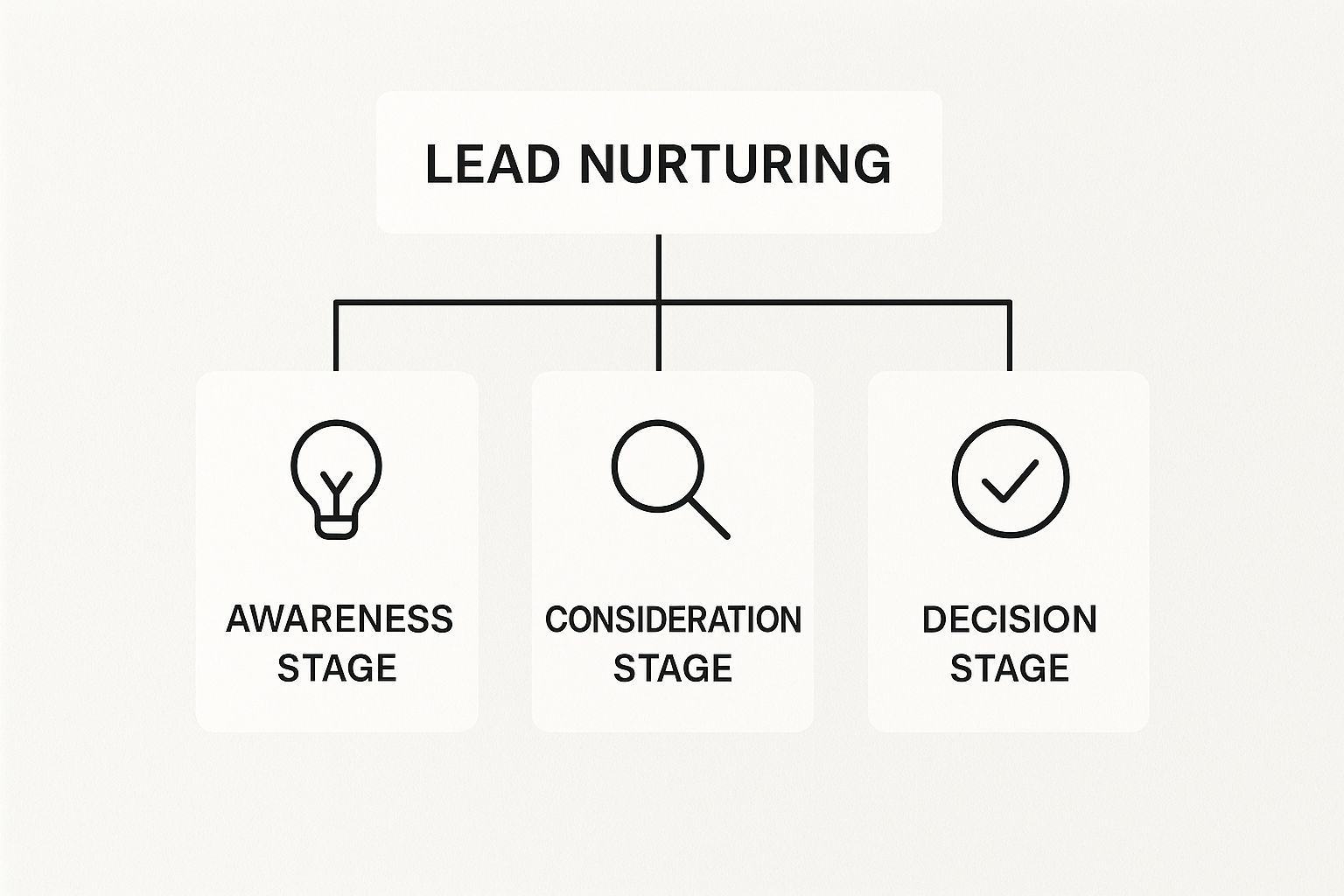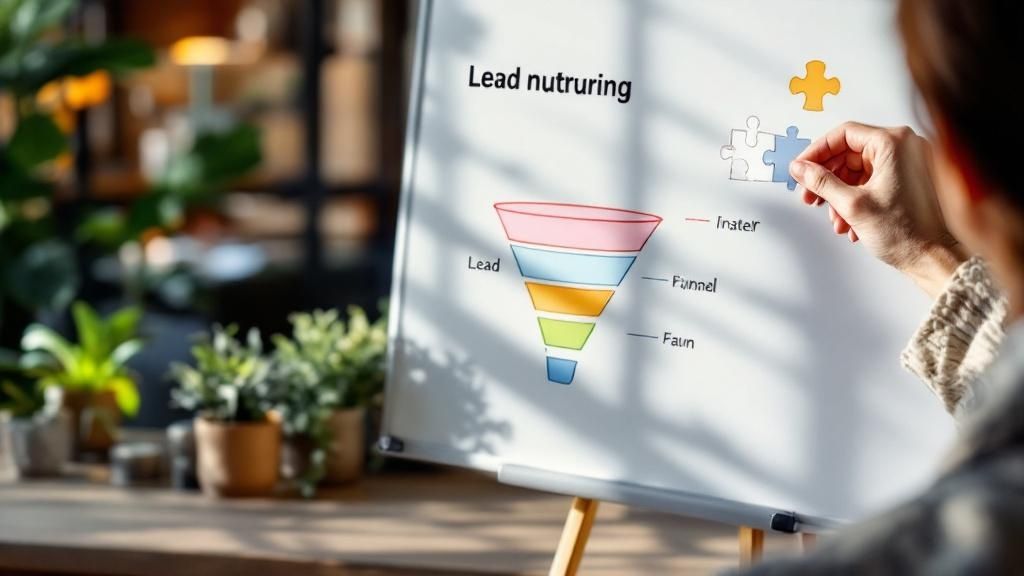Lead nurturing is all about building and maintaining relationships with potential customers, no matter where they are in their buying journey. It's for the prospects who are interested but not quite ready to pull out their wallets today. By consistently providing value, you can gently guide them from that initial spark of interest toward a final purchase, turning a lukewarm lead into a long-term fan.
The Foundation of Lasting Customer Relationships
Think of your marketing efforts like a gardener tending to a new plant. You wouldn't just toss a seed in the ground and hope for the best, right? Of course not. You'd give it the right amount of water, sunlight, and care to help it grow strong. That’s exactly what lead nurturing is—it transforms marketing from a one-off pitch into a real, ongoing partnership built on a foundation of trust.
The whole point is to stay on their radar by delivering the right information at just the right moment. Instead of a hard sell, you're educating and helping your prospects, positioning your brand as the go-to expert they can rely on. This kind of systematic, patient approach is what truly drives sustainable growth.
The numbers really drive this point home. A staggering 80% of new leads never actually turn into sales, which makes having a structured follow-up process an absolute must. And get this: companies that get lead nurturing right see email response rates that are 4 to 10 times higher than what you'd get from a generic email blast. You can dig into these powerful stats over at Zendesk.
To truly master lead nurturing, you need a solid grasp of its core components. These pillars work together to create a cohesive strategy that meets your prospects' needs at every turn.
Here's a quick breakdown of what a strong lead nurturing strategy is built on:
Core Components of a Lead Nurturing Strategy
| Component | Description | Key Goal |
|---|---|---|
| Buyer's Journey | Understanding the distinct stages a prospect goes through before making a purchase. | Deliver the right content at the right time. |
| Segmentation | Grouping leads based on shared characteristics like demographics, behavior, or interests. | Personalize communication for maximum relevance. |
| Content Mapping | Aligning specific content pieces to each stage of the buyer's journey. | Address the prospect's evolving questions and needs. |
| Automation | Using software to deliver timely messages and track engagement without manual effort. | Nurture leads at scale and ensure consistency. |
| Metrics & KPIs | Tracking key data points to measure the effectiveness of your nurturing efforts. | Optimize your strategy for better results over time. |
By focusing on these elements, you can build a nurturing machine that not only converts leads but also fosters genuine customer loyalty.
Understanding the Buyer's Journey
To nurture leads effectively, you absolutely have to understand the path they take. This "buyer's journey" is typically broken down into three main stages. Each one requires a completely different kind of conversation and content to meet the lead where they are.
- Awareness Stage: The prospect is just realizing they have a problem and is doing research to understand it better. Your content here should be purely educational and focused on their pain points, not your product.
- Consideration Stage: Now, the prospect has a name for their problem and is actively looking at different ways to solve it. This is where your content should shift to highlight how your specific solution can help.
- Decision Stage: The prospect is ready to make a choice and is comparing you against competitors. Case studies, demos, and clear pricing information are your best friends at this stage.
This diagram does a great job of showing how lead nurturing acts as a guide through these distinct phases.

As the visual shows, a successful strategy isn't a single action but a layered process that adapts to the prospect's changing needs. When you recognize and cater to these stages, you build a relationship that leads to a confident "yes" at the end. Not only that, but it often leads to much bigger deals—in fact, nurtured leads can generate orders that are 47% higher in value than those from non-nurtured prospects.
Why Nurturing Leads Is a Non-Negotiable for Growth

Let's be real: collecting leads without a plan to follow up is like filling a bucket with holes. You pour time and money into getting people interested, but without a real process, all that potential revenue just leaks away. Lead nurturing is the patch that stops those leaks, turning a flicker of curiosity into actual business growth.
Think about two companies. Company A drops thousands on ads, collects a bunch of emails, and then… crickets. Those leads go cold, forget who the company even is, and become a sunk cost. Company B, on the other hand, sees every new lead as the beginning of a conversation. They have a system to follow up, share useful stuff, and stay on their radar. That’s what separates a stagnant business from one that scales.
When you take the time to build these relationships, you're doing more than just pushing for a sale. You're creating fans of your brand. That's the whole point of lead nurturing—to turn your marketing spend into a long-term, revenue-generating machine.
The Tangible Business Impact of Nurturing
A solid lead nurturing strategy hits your bottom line directly by making your entire sales process smarter, not harder. Instead of your sales team chasing down cold prospects, they get to talk to people who are already warmed up, familiar with your brand, and clued into what you offer. This one shift can totally change the game for your conversion rates and how fast you bring in revenue.
The numbers don't lie. Businesses that nail lead nurturing generate 50% more sales-ready leads while spending 33% less to get each one. On top of that, these nurtured leads tend to make decisions faster, leading to a 23% shorter sales cycle. That's a massive efficiency gain.
A proactive nurturing strategy doesn’t just keep you top-of-mind; it actively prepares prospects for a sales conversation, ensuring your team’s time is spent on opportunities with the highest potential to close.
From Wasted Leads to Predictable Revenue
Ultimately, every business wants sustainable growth, and lead nurturing is the engine that gets you there. It builds a predictable pipeline of qualified prospects, smoothing out the "feast or famine" rollercoaster many companies are stuck on. That consistency makes everything from forecasting to resource planning so much easier.
To make this happen, you need a system. The key moving parts usually include:
- Timely Follow-Up: You have to jump on leads right after they show interest. That's when their curiosity is at its peak.
- Value-Driven Content: Give them something useful. Blog posts, case studies, and practical guides that actually help solve their problems build incredible trust.
- Personalized Communication: Don't send the same generic message to everyone. Segment your audience so you can send notes that are genuinely relevant to them and where they are in their buying journey.
Getting these practices dialed in is critical. To see how these ideas come together in a real-world workflow, take a look at our guide on how to nurture leads and close more deals. When done right, nurturing transforms your lead list from a static database into a living asset that constantly fuels your growth.
Essential Strategies for Your Nurturing Campaigns

Alright, let's move past the theory. Effective lead nurturing isn't just a concept; it’s about building repeatable systems that work. Think of it as a series of helpful, well-timed touchpoints that guide a prospect forward, not just a sequence of sales pitches.
The best strategies are multi-channel, genuinely personal, and timed to match a lead's actual behavior. At the heart of it all? A solid, comprehensive email marketing plan. While social media and other channels have their place, email is still the undisputed workhorse for building direct, one-on-one relationships at scale.
It's surprising how many businesses haven't formalized this process. Research shows that about 65% of marketers still don’t have a lead nurturing program in place. For those who do, email is the top channel, used by 69%, and 62% of B2B marketers use nurturing to segment leads based on their actions. This gap is a massive opportunity for anyone willing to put a structured approach into motion.
Personalization and Segmentation
If you take one thing away from this, let it be this: make your communication feel personal. Generic, one-size-fits-all messages are the fastest way to get ignored. The secret is segmentation—dividing your audience into smaller, more relevant groups.
You can slice and dice your lead list based on all sorts of things:
- Demographics: Grouping by industry, company size, or job title.
- Behavior: Tracking which pages they visit, what content they download, or if they opened your last email.
- Source: Treating leads from a webinar differently than those from an organic search.
By segmenting, you can send content that speaks directly to a lead's challenges and interests. It turns your outreach from a monologue into a relevant conversation, which is exactly what drives real engagement. Of course, this all starts with a steady stream of prospects. Our guide on 5 lead generation strategies and tips can help you fill your pipeline with quality contacts ready to be nurtured.
Multi-Channel Nurturing Workflows
While email is your foundation, a truly great strategy uses multiple channels to create a cohesive experience. This means your message is consistently reinforced across the platforms your prospects actually use every day.
A multi-channel workflow could look something like this:
- Email Welcome Series: An automated sequence of 3-5 emails for new leads, introducing your brand and offering immediate value.
- Social Media Retargeting: Showing targeted ads on platforms like LinkedIn to leads who have visited specific pages on your website.
- Content Offers: Promoting relevant case studies or whitepapers based on a lead’s engagement level.
The goal is to be helpfully present, not annoyingly persistent. Each touchpoint should add value and build on the last, creating a seamless journey from curiosity to conversion.
Implementing Lead Scoring
So, how do you know when a lead is actually ready for a sales call? That's where lead scoring comes in. It’s a simple system for assigning points to leads based on who they are and what they do.
Lead Scoring: A method for ranking prospects on a scale that represents their value to your business. This score helps you decide which leads are warm enough to pass to sales for a direct follow-up.
For instance, you might set up your scoring like this:
- +10 points for visiting the pricing page.
- +5 points for downloading an ebook.
- +20 points for requesting a demo.
- -5 points for being inactive for 30 days.
Once a lead hits a certain score (say, 50 points), they're automatically flagged as a Marketing Qualified Lead (MQL) and sent over to your sales team. This simple system ensures reps focus their energy on the most promising prospects, which is a surefire way to improve efficiency and close more deals.
Building Your Lead Nurturing Tech Stack
Let's be honest, you can have the most brilliant lead nurturing strategy in the world, but without the right tools to back it up, it’s just a collection of good intentions. Executing it properly demands technology.
Building a “tech stack” might sound like a job for your IT department, but it’s really just about picking a few core tools that talk to each other to automate and scale your outreach. Trying to manage this process with spreadsheets and sticky notes is a surefire way to let high-potential leads fall through the cracks.
The whole point is to create a seamless system. Data should flow from one platform to another, triggering the right message at the right time to guide leads along their path. Think of these tools as the engine of your nurturing machine, working 24/7 in the background so you can focus on strategy and creating great content.
Three types of software are the bedrock of pretty much any modern lead nurturing setup. Each one has a distinct job, but they all work together to turn a list of names into a pipeline of sales-ready opportunities.
The Three Pillars of Nurturing Technology
Your tech stack doesn’t need to be overwhelmingly complex. In fact, simpler is often better. It just needs to do three things really well: manage data, run the campaigns, and tell you what’s working.
Here are the three pillars you can't build without:
- Customer Relationship Management (CRM): This is your command center. A CRM is the single source of truth for every bit of information you have on a lead or customer—contact details, every interaction, call logs, you name it. It keeps your sales and marketing teams on the same page.
- Marketing Automation Platform: This is where the action happens. A marketing automation tool is what actually sends your email sequences, tracks who’s visiting your website, scores leads based on their activity, and segments your audience automatically.
- Analytics and Reporting Tools: These tools are your report card. They track the crucial metrics like open rates, click-through rates, and, most importantly, conversions. This is how you know if your efforts are actually paying off and where you need to make adjustments.
Key Takeaway: A well-integrated tech stack is everything. When your CRM, marketing automation, and analytics tools are all communicating, you get a full 360-degree view of a lead's journey. That's what allows you to deliver those perfectly timed, personalized touches that actually work.
Comparing Your Tech Stack Options
Picking the right software can feel like a huge task, but it gets a lot easier when you focus on the primary job of each tool. While some all-in-one platforms try to do everything, understanding the core function helps you see where the real gaps are in your current setup.
Here’s a simple table to break down the key differences and help you figure out what you need.
Lead Nurturing Technology Comparison
This table compares the primary functions of essential tools in a lead nurturing tech stack to help businesses choose the right solutions.
| Tool Type | Primary Function | Key Features for Nurturing |
|---|---|---|
| CRM | Manages customer relationships and data. | Lead contact storage, interaction tracking, sales pipeline visibility. |
| Marketing Automation | Executes and automates marketing campaigns. | Automated email workflows, behavior tracking, lead scoring. |
| Analytics Tools | Measures campaign performance and ROI. | KPI dashboards, A/B test reporting, conversion funnels. |
Ultimately, having a clear understanding of what each type of tool brings to the table ensures you're not just buying software, but building a cohesive system that drives real results.
Measuring Success and Optimizing Your Efforts

A great lead nurturing strategy isn’t just built on good ideas and guesswork; it’s shaped by cold, hard data. To figure out if your efforts are actually paying off, you have to measure what really matters for business growth. That means looking past vanity metrics like social media likes and zeroing in on the numbers that directly impact your bottom line.
Without clear metrics, you're flying blind. You might feel busy sending emails and creating content, but you won't know if any of it is actually shortening your sales cycle, boosting deal sizes, or creating more loyal customers. Tracking the right data is what separates a busy marketing team from an effective one.
A data-driven approach isn't optional. It’s the only way to prove the value of your nurturing activities and make smart tweaks that improve performance over time, making sure every dollar in your marketing budget pulls its weight.
Key Metrics That Truly Matter
To get a clear picture of your campaign’s health, you need to track a handful of core metrics. These KPIs give you real insight into how well your lead nurturing is turning casual interest into actual revenue.
Here are the essentials you should be watching:
- Lead-to-Customer Conversion Rate: This is the big one. It tells you exactly what percentage of the leads you’re nurturing end up becoming paying customers.
- Sales Cycle Length: How long does it take to turn a new lead into a closed deal? A solid nurturing program should shrink this timeline by educating prospects and building trust more quickly.
- Customer Lifetime Value (CLV): Nurtured leads don’t just close; they often become better, more loyal customers. Tracking CLV shows if your efforts are building high-value relationships that pay off for years to come.
These metrics give you a 360-degree view of your performance, helping you draw a straight line from your nurturing campaigns to your revenue goals. To get your pipeline in shape from the very beginning, check out our guide on powerful B2B lead generation strategies that attract the right kind of prospects.
A Framework For Continuous Improvement
Your first nurturing campaign will never be your best one—and that’s a good thing. The secret to long-term success is a commitment to constantly optimizing through testing and analysis. This is how you turn good campaigns into great ones.
A simple but incredibly powerful way to do this is with A/B testing. The idea is to change one single element in your campaign—just one—and measure how that change affects performance. By systematically testing different components, you can slowly but surely discover what your audience responds to.
Consider testing these elements to start:
- Email Subject Lines: Try out different tones, lengths, and levels of personalization to see what gets you the highest open rates.
- Content Offers: Does your audience want a deep-dive whitepaper or a simple checklist? Test different formats to see what drives more downloads.
- Calls-to-Action (CTAs): Play with different wording, button colors, and placement to find out what gets the most clicks.
By consistently testing, measuring the results against your core KPIs, and rolling out the winning variations, you create a powerful feedback loop. This cycle ensures your lead nurturing strategy doesn't just run on autopilot—it evolves, getting sharper, more effective, and more profitable over time.
Common Lead Nurturing Questions Answered
As you start to map out your own lead nurturing strategy, some practical questions will almost certainly bubble up. Getting a real feel for what lead nurturing is—and just as importantly, what it isn't—is the key to making it work for you.
Think of this as your quick-fire guide to clearing up those common sticking points. Once these core ideas click, your whole team can get on the same page and start building real relationships with future customers.
How Is Lead Nurturing Different From Lead Generation?
Lead generation is the very first move you make. It’s all about attracting potential customers and getting their contact info in the first place. Think of it as filling the top of your sales funnel with fresh contacts who’ve shown that initial spark of interest.
Lead nurturing, on the other hand, is everything that comes after that moment. It's the ongoing conversation you start to build trust and gently guide them toward making a purchase.
Here's a simple way to think about it: lead generation is like getting someone's phone number at a party. Lead nurturing is the series of thoughtful texts and calls that follow, building a genuine connection that eventually leads to a first date. One is pure acquisition; the other is all about the relationship.
Getting this distinction right is critical. Generation gets prospects in the door, but nurturing is what convinces them to stick around, listen to what you have to say, and, eventually, buy from you. Without a solid nurturing plan, even the most successful lead gen efforts fizzle out into missed opportunities.
When Should I Start Nurturing a Lead?
The short answer? Immediately.
The second a prospect gives you their contact information—whether they downloaded an ebook, signed up for your newsletter, or filled out a form—the clock is officially ticking. That very first interaction sets the tone for everything that follows.
This initial touchpoint is your golden opportunity to make a great impression and prove they made the right call. A quick, automated welcome email that delivers exactly what you promised (like a link to the resource they asked for) is the perfect opening move. From there, you can kick off a steady, value-packed communication cadence. Don’t wait for them to go cold; the relationship starts on day one.
Can Small Businesses Afford to Do Lead Nurturing?
Absolutely. This is probably one of the biggest myths out there. At its heart, lead nurturing is a strategy, not just a suite of pricey tools. A small business can get started and see real results with little more than an affordable email marketing platform.
The focus should always be on providing consistent value, not on having the most complicated automation setup money can buy. You can start small by:
- Manually sorting your audience into simple groups based on what they were first interested in.
- Creating a basic, automated welcome email series for any new contact.
- Sending out a monthly newsletter packed with helpful tips and insights.
As your business grows and your needs get more complex, you can look into investing in more advanced tech. But the core principle of building relationships is something any business can scale, no matter its size or budget.
Ready to turn your leads into loyal customers? Salesloop.io provides the tools you need to automate your outreach, personalize your messaging, and scale your growth. See how our multichannel sales outreach platform can transform your B2B lead generation at Salesloop.io.





